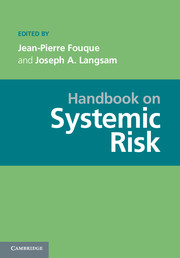Book contents
- Frontmatter
- Contents
- Contributors
- Introduction
- PART I DATA: THE PREREQUISITE FOR MANAGING SYSTEMIC RISK
- PART II STATISTICS AND SYSTEMIC RISK
- PART III MEASURING AND REGULATING SYSTEMIC RISK
- PART IV NETWORKS
- 11 Network Models and Systemic Risk Assessment
- 12 Strategic Interactions on Financial Networks for the Analysis of Systemic Risk
- 13 Network Structure and Systemic Risk in Banking Systems
- PART V SYSTEMIC RISK ANDMATHEMATICAL FINANCE
- PART VI COUNTERPARTY RISK AND SYSTEMIC RISK
- PART VII ALGORITHMIC TRADING
- PART VIII BEHAVIORAL FINANCE: THE PSYCHOLOGICAL DIMENSION OF SYSTEMIC RISK
- PART IX REGULATION
- PART X COMPUTATIONAL ISSUES AND REQUIREMENTS
- PART XI ACCOUNTING ISSUES
- References
12 - Strategic Interactions on Financial Networks for the Analysis of Systemic Risk
from PART IV - NETWORKS
Published online by Cambridge University Press: 05 June 2013
- Frontmatter
- Contents
- Contributors
- Introduction
- PART I DATA: THE PREREQUISITE FOR MANAGING SYSTEMIC RISK
- PART II STATISTICS AND SYSTEMIC RISK
- PART III MEASURING AND REGULATING SYSTEMIC RISK
- PART IV NETWORKS
- 11 Network Models and Systemic Risk Assessment
- 12 Strategic Interactions on Financial Networks for the Analysis of Systemic Risk
- 13 Network Structure and Systemic Risk in Banking Systems
- PART V SYSTEMIC RISK ANDMATHEMATICAL FINANCE
- PART VI COUNTERPARTY RISK AND SYSTEMIC RISK
- PART VII ALGORITHMIC TRADING
- PART VIII BEHAVIORAL FINANCE: THE PSYCHOLOGICAL DIMENSION OF SYSTEMIC RISK
- PART IX REGULATION
- PART X COMPUTATIONAL ISSUES AND REQUIREMENTS
- PART XI ACCOUNTING ISSUES
- References
Summary
Abstract We illustrate how a network-based analysis can be useful to the evaluation of systemic risk, highlighting the abilities of a network model in terms of identification and measurement of the system-wide effects. Beginning with the methodological framework used in the social interactions literature, we discuss the use of behavior-based models in the financial markets context and relate our approach to that used in the epidemiological literature. Using these ideas, we define a new measure of systemic risk. Our measure differs from existing approaches in that it depends on the specific network architecture and will be a function of the strategic behavior of agents in the system. The measure is a quantification of the average impact of a shock that emerges as the result of the strategic reaction of market participants. We provide an application of this approach discussing the role of correlated trading strategies in fully electronic exchanges. While such markets offer no ability for traders to choose their transaction partners, the realized pattern of trades resembles a highly organized network. Importantly, these network patterns are closely related to profitability in the market; certain positions in the network are more valuable than others. As well, the observed structure of the network implies a very large impact of shocks to the system. We conclude with some policy implications and suggestions for future research.
Keywords Financial networks, systemic risk, interconnections. JEL Classification G10, C21.
- Type
- Chapter
- Information
- Handbook on Systemic Risk , pp. 306 - 326Publisher: Cambridge University PressPrint publication year: 2013
References
- 8
- Cited by



